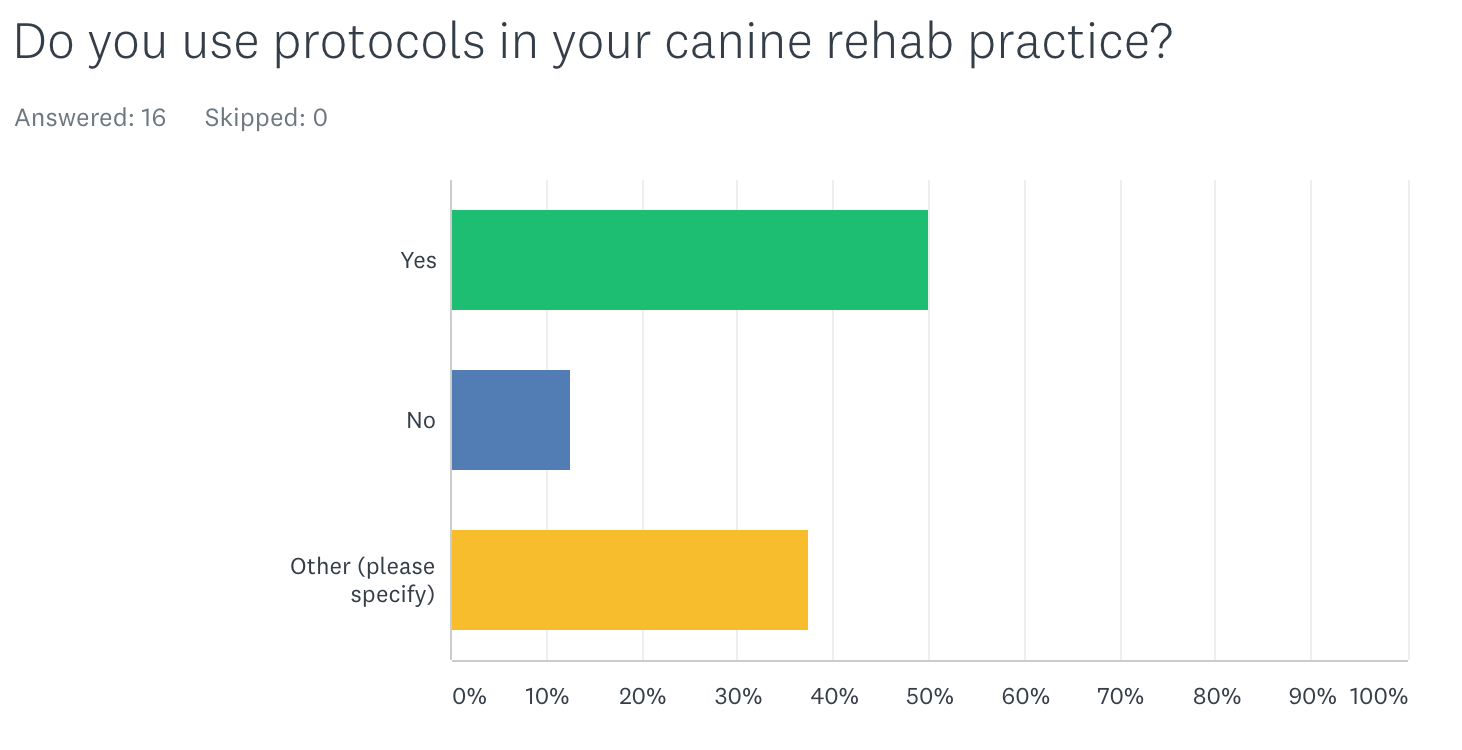Laurie's Blogs.
Feb 2020
Protocol Survey Responses
Thank you so much to everyone that responded to the survey I put up last week. Today I’m sharing with you the responses. I love survey responses! We should do more of this! Okay, here we go!
This first question was simply, “Do you use protocols in your canine rehab practice?”

Essentially 50% responded “Yes”, 12.5% responded “No”, and 37.5% responded “Other”. Those that chose to qualify their response for ‘other’ pretty much commented that they use them as guidelines only. This sentiment is reflected below in question 3.
Where have your protocols come from?
Self-created: 9
CRI / Courses / UT: 7
FourLeg: 7
Books: 6
From surgeons / in collaboration with surgeons: 3
Other: Top Dog, Chris Zink
Interesting comments:
“I created them after realizing I tend to prescribe similar methods for patients in simliar stages of healing for the more "typical" conditions (TPLO, lateral suture, FHO/FHNE etc)”
“I initially gathered up various protocols to get me started. However, the more experience I gained, the more I realized the protocols were getting in the way of offering the best approach for my canine clients. Some of the protocols I quite disagree with now. Also, with post op dogs, I find the timelines from the vets differ considerably for some things.”
What is most interesting here is that the majority of respondents found that they had to create protocols themselves. This makes sense. There is either a total lack of protocols (or non-rehab specific) protocols created for the various procedures by surgeons themselves. OR (and what would be more appropriate) lack of protocols created by surgeon – rehab professional collaboratively. However, even if the latter were the case, it would most likely only be specific to that surgeon and that surgical technique. So, I think that what is going on is most appropriate anyways.
Anything else you’d like to share?
This is always the most enlightening question to ask in any survey! So, I’m just going to cut and paste the responses.
“Early on I found protocols necessary as reminders/guides but the more I do, the more I see a need for individualized treatment”
“Protocols I use are usually case-related, specific for each individual, not for the disease”
“Like you suggest, I use my general protocol as a guideline and honestly a time saver (for both myself and my nursing staff), then I tailor that protocol to fit the individual patient/client need”
“We use them as a rough draft, to be changed as the patient status and needs change. Since we have a few clinicians at the clinic working, it keeps us all somewhat on the same page. It prevents the scenario when a dog comes in, sees another clinician and the first PT did something vastly different. There is some cohesiveness, continuum of care, with flexibility.”
“Predominantly use them for post-op/post-injury patients where the tissue healing time will dictate which therapies/exercises can be used at certain points”
“What I have found is truly animals heal at such a different rate, and I have to adjust for things like what the owner can physically do, what the animal is comfortable doing from a capability/fear/handling stand point (ie. owner can't get down on ground, owner cannot bend over, dog will not allow handling of feet, etc) . Furthermore, I find the guidelines are truly "best case scenario" types of situations and I have MULTIPLE owners (often sport clients) who are upset that their dog is not back to running agility courses at 4 months post-op TPLO. I tend to go a bit slower, but I progress them so much that every part of their recovery to sport for instance, is trained with a similar rehab exercise. I make a lot of my exercises up, and often have to work with what owners have at home as well.”
“Mine are mostly home exercise/treatment programs, individualized for dog and owner. It is just a starting point that saves me from typing everything, every time, for the client.”
“I think guidelines are ok.”
“Assessing the individual owners and patient - what they are capable of, time wise, logistically and physically is a big part of my eval.”
“As an RMT we are also trained that there aren't recipes for treating patients. Protocols are potential ideas that may work.”
“I agree with the blog that they are guidelines not recipes. The downside of sharing them with non rehab trained vet colleagues is they want to use them a definitive recipes!!! Hence rather than protocols I offer them broad guidelines and then tell them I adapt them to the specific needs of that animal and owner”
“I believe that rehab should not be driven by protocols. I also think that exercises should be evaluated by physio and owners taught correct methods. I am against showing just a video.. and owners told to do that.”
And thank you to whomever wrote in:
“Thank you for who you are :)"
I appreciate that!
So, there you have it! I think there is some degree of consensus. Protocols should be used as guidelines. They might be a starting point from which to design a program but that tailoring to the individual patient is important. Most rehab professional respondents have had to create their own protocols with the help of existing resources. I’m sure this is an area that will grow and evolve as the practice of canine rehab grows and evolves as well!


